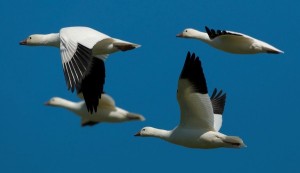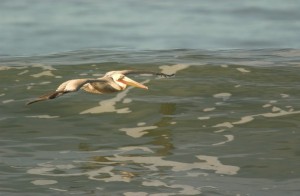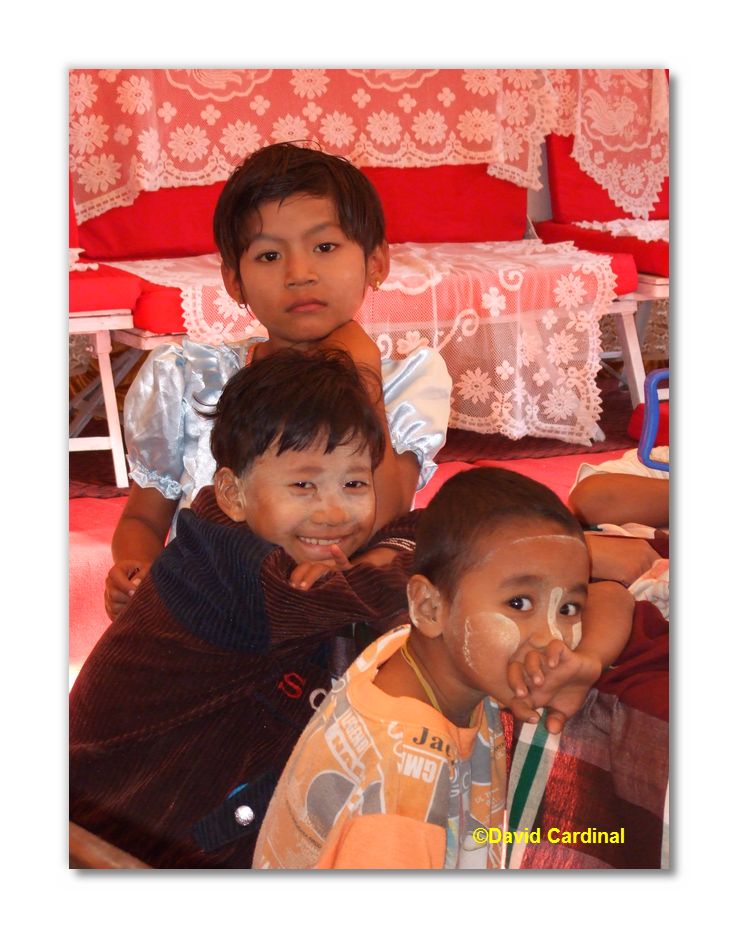- Photo Safaris
- Alaska Bears & Puffins World's best Alaskan Coastal Brown Bear photo experience. Small group size, idyllic location, deluxe lodging, and Puffins!
- Participant Guestbook & Testimonials Candid Feedback from our participants over the years from our photo safaris, tours and workshops. We don't think there is any better way to evaluate a possible trip or workshop than to find out what others thought.
- Custom Photo Tours, Safaris and Personal Instruction Over the years we've found that many of our clients & friends want to participate in one of our trips but the dates we've scheduled just don't work for them or they'd like a customized trip for their family or friends.
- Myanmar (Burma) Photo Tour Myanmar (Burma) Photo Tour December 2017 -- with Angkor Wat option
- Reviews Go hands-on
- Camera Reviews Hands-on with our favorite cameras
- Lens reviews Lenses tested
- Photo Accessories Reviews Reviews of useful Photo and Camera Accessories of interest to our readers
- Useful Tools & Gadgets Handy tools and gadgets we've found useful or essential in our work and want to share with you.
- What's In My Camera Bag The gear David Cardinal shoots with in the field and recommends, including bags and tools, and why
- Articles About photography
- Getting Started Some photography basics
- Travel photography lesson 1: Learning your camera Top skills you should learn before heading off on a trip
- Choosing a Colorspace Picking the right colorspace is essential for a proper workflow. We walk you through your options.
- Understanding Dynamic Range Understanding Dynamic Range
- Landscape Photography Tips from Yosemite Landscape Photography, It's All About Contrast
- Introduction to Shooting Raw Introduction to Raw Files and Raw Conversion by Dave Ryan
- Using Curves by Mike Russell Using Curves
- Copyright Registration Made Easy Copyright Registration Made Easy
- Guide to Image Resizing A Photographers' Guide to Image Resizing
- CCD Cleaning by Moose Peterson CCD Cleaning by Moose Peterson
- Profiling Your Printer Profiling Your Printer
- White Balance by Moose Peterson White Balance -- Are You RGB Savvy by Moose Peterson
- Photo Tips and Techniques Quick tips and pro tricks and techniques to rapidly improve your photography
- News Photo industry and related news and reviews from around the Internet, including from dpreview and CNET
- Getting Started Some photography basics
- Resources On the web
- My Camera Bag--What I Shoot With and Why The photo gear, travel equipment, clothing, bags and accessories that I shoot with and use and why.
- Datacolor Experts Blog Color gurus, including our own David Cardinal
- Amazon Affiliate Purchases made through this link help support our site and cost you absolutely nothing. Give it a try!
- Forums User to user
- Think Tank Photo Bags Intelligently designed photo bags that I love & rely on!
- Rent Lenses & Cameras Borrowlenses does a great job of providing timely services at a great price.
- Travel Insurance With the high cost of trips and possibility of medical issues abroad trip insurance is a must for peace of mind for overseas trips in particular.
- Moose Peterson's Site There isn't much that Moose doesn't know about nature and wildlife photography. You can't learn from anyone better.
- Journeys Unforgettable Africa Journeys Unforgettable -- Awesome African safari organizers. Let them know we sent you!
- Agoda International discounted hotel booking through Agoda
- Cardinal Photo Products on Zazzle A fun selection of great gift products made from a few of our favorite images.
- David Tobie's Gallery Innovative & creative art from the guy who knows more about color than nearly anyone else
- Galleries Our favorite images
DPS 5-07: Flight Photo Tips & Techniques, Burma (Myanmar) Update
DigitalPro
Shooter
DPS 5-07: The Perfect Trio of Flight Photography, Photographing Terns Fishing & an Update on Burma (Myanmar)
We'll start this issue with some tips for making the most out of your flight photo opportunities. Then we've got a special article on how to photograph Terns fishing and learning to fish by experience nature photographer Adam Felde, and a quick update on the political situation in Burma (Myanmar).
Photo Safari Updates: The May Botswana trip is starting to fill up, as are the July Alaska Bear & Puffin Trips. We may have one opening for the April Texas bird trip, otherwise we'll start a waiting list. The Southeast Asia trip is coming up soon but we could still accomodate someone if they act quickly.
The Perfect Trio of Flight Photography
|
Sun, Wind and Sky are the Perfect Trio of flight photography. Learn how to use them to your advantage in this article full of tips. |
Besides the expected technical issues of focus and sharpness great flight photographs require some attention to the environment--in this case the wind, sun, and sky, the big three of flight photography. While some birds like Vultures will glide even on the calmest days, getting good flight poses of birds taking off, landing and even leisurely soaring is best when there is enough wind to give the birds a direction and provide them with lift.
Sun and Wind
One of the best aspects of flight photography is that it can be much more forgiving of bright light than photographing perching birds--because blue sky is such a wonderful middle-tone background that is much easier for your camera to capture along with a bird than most foliage. So the ideal sunlight for flight photography can be fairly bright, which will also help to create some good color in the sky behind the bird. Low light flight shots, by contrast, emphasize the drama of flight although it can be harder to get enough shutter speed to create a sharp image.
Like airplanes it is easiest for birds to take off and land into the wind, so once you know the direction of the wind you know which way to expect the birds to be headed during those key moments. That quickly ties to the position of the sun, since we also want our birds front-lit and looking towards the sun. Some simple geometry tells us we can achieve both of these objectives if the wind is heading out of the Sun. When that happens we can face away from the light and towards the birds knowing that they will be maneuvering on their trips towards us. Often the heat on the shore rising will cause a breeze to blow from the water towards the shore. Depending on the way the shore faces you can predict what time of day will be best to get your favorite birds flying into the light.
Backgrounds
But good flight shots aren't great unless they have a rich, contrasting background. White sky just won't cut it. Even with all the photoshop work in the world a bird against a white sky is unlikely to look great. We want either a deep blue sky or perhaps a dark gray--gray can be especially effective with some high-contrast birds like Bald Eagles. Green is another option, but it is much harder to create an intersting flight composition without too much contrast against a green background than against sky blue. Brown mountains can also work but they too are a lot tougher target.
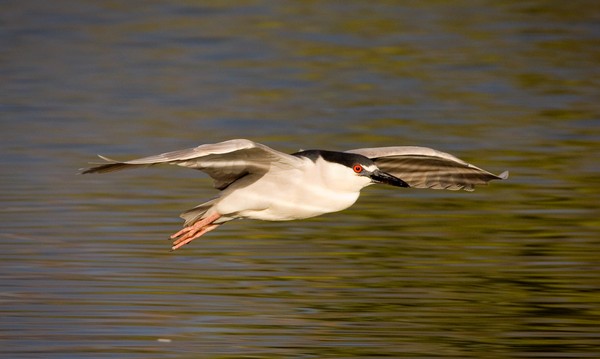
Calm water can be a great background, just like the Sky
Nikon D2X, 600f/4, 1/350s @ f11
Black-crowned Night Heron Gliding, David Cardinal
| For some birds like Brown Pelicans, Puffins, Murres and other seabirds the ocean can be an appealing and interesting substitute for the sky. Because Pelicans often float along the waves for miles in groups they make great practice subjects for flight photography and can create some compelling images. Puffins and other seabirds are faster moving and can be much harder to focus on, but again since they are often flying level with the water it can be easier to practice with them than with birds flying willy-nilly up in the sky. |
Cardinal Photo Safaris Update:
|
||||||||||
Flight Behaviors
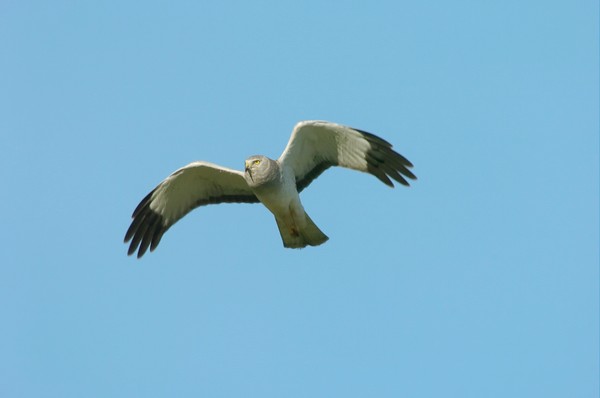
Male Northern Harrier Hovering looking for Prey
Nikon D2X, 600f/4, f8 @ 1/800s
David Cardinal
Hovering is another behavior which is easiest to photograph when you have the "big three" of sun, wind and sky going your way. Since birds are often hovering to help them spot prey they don't seem that eager to do it facing into the sun. But of course that is the direction we need them to be looking. That's where the wind helps us out. Raptors will tend to hover facing into the wind so we can photograph them most easily when the wind is coming out of the Sun.
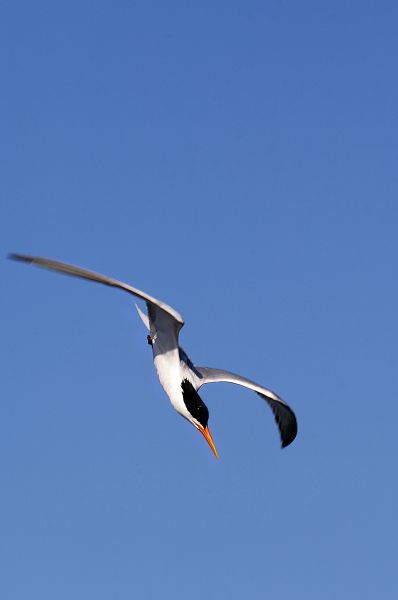
Tern Diving for Fish
Photo by Adam Felde
Fishing Birds
Plunging for fish is one of the most explosive and exciting behaviors to capture with images. Newsletter reader and nikondigital.org forum contributor Adam Felde has been photographing Terns teach their young to fish for several years and has been kind enough to publish a great how-to article on the site. You can read Adam's tips at: Tern Photography Tips.
Getting Started with Flight Photography
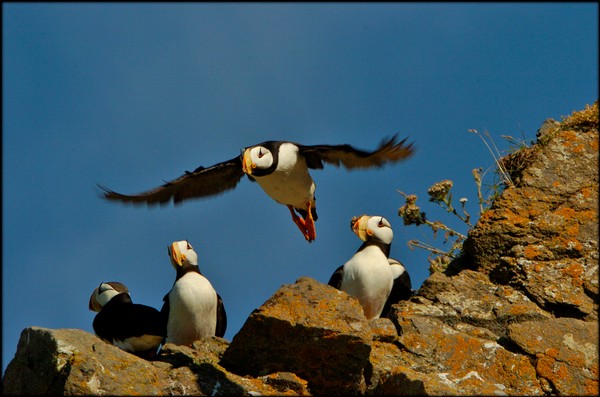
Horned Puffin taking off from cliff
Alaska Photo Safari, David Cardinal
The simplest way to get started with flight photography is to look for the times when the birds are hardly moving. In addition to hovering this includes take off and landing into a strong wind. When we photograph Puffins during our Alaska photo safaris every July, for example, it's relatively simple to get a nice shot of them as they leap off the cliffs or as they spread their wings and feet coming in for a landing, but can be harder to pan accurately enough to catch them as they fly overhead.
The Dark Side of Light: Heat Shimmer
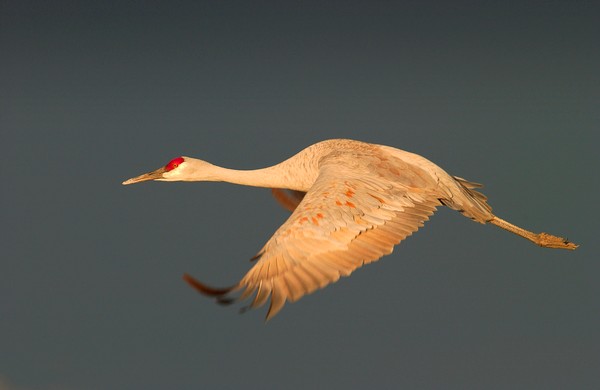
One way to combat heat shimmer is to wait until evening when the ground has cooled off.
Sandhill Crane at Sunset, David Cardinal
There is a dark side to having all the elements lined up in our favor. Often the same heat that helps generate the wind creates heat shimmer. Heat shimmer is definitely your enemy when it comes to any type of photography. Even if it isn't visible in your photographs it can show itself by lowering the contrast and sharpness of your images. You may be stuck blaming your lens, camera or technique when the problem is some poor timing. If you do see heat shimmer try getting as close to your subject as possible. And the heat shimmer is worst closest to the ground so capturing subjects up in the sky can also help. Once the heat has gone out of the sunlight the wind will start to blow the heat shimmer off, but it can take awhile.
Other Flight Photography Resources:
Moose Peterson's Guide to Wildlife Photography (Updated for Digital):
A must read for anyone serious about wildlife photography of any kind. The digital updates are well worth buying the new version even if you already have the older one.
Art Morris's Art of Bird Photography:
Art is perhaps the world's best known bird photographer, with good reason. He has put a lot of work into the best way to photograph birds and is gracious about sharing his secrets in his writing.
Burma (Myanmar) in the News
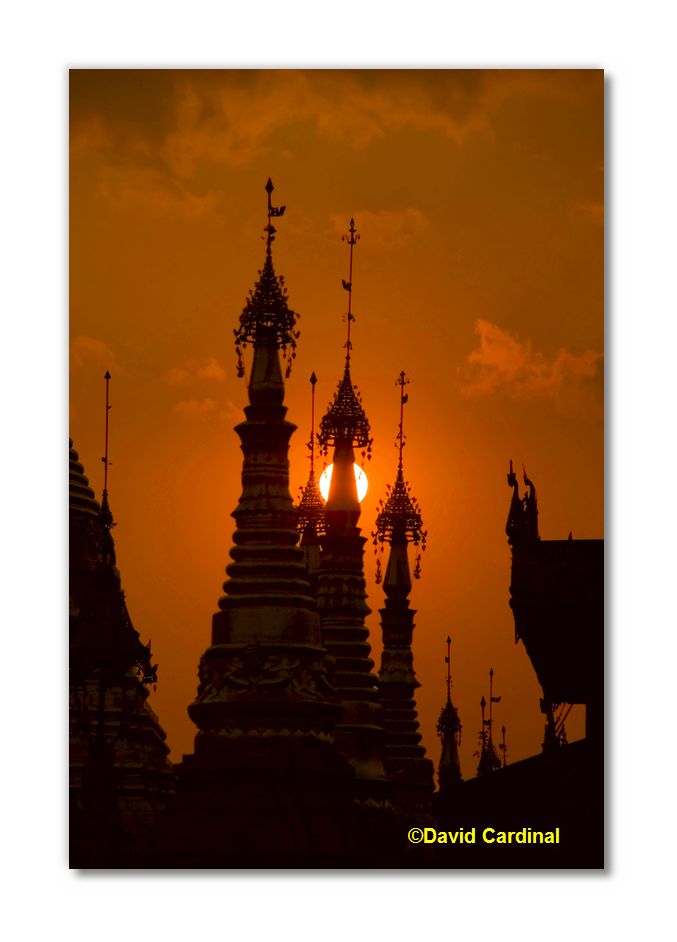 Scwedagon at Sunset, Yangon, Burma Nikon D2X, David Cardinal |
For a country many Americans have only heard about in works of fiction or perhaps in historic chronicles of the British Empire it has been hard to miss the ongoing confrontations taking place in Burma this month. Burma is a country I have greatly enjoyed visiting and photographing on two trips in the last few years. The people we have met there are wonderful, caring, and eager to meet and speak with Americans of all kinds. They have a variety of wonderful cuisines and an unparelleled historic legacy of Buddhist temples dotting the landscape. The US was instrumental in freeing Burma from the Japanese occupation in World War II. So there is a deep resovoir of goodwill towards Americans among the population, which makes it an especially friendly country to visit. |
|
Leaving aside the political controversy there, the personal controversy we gets asked about is the role of tourism and sanctions. For most of the last 20 years the US has had some form of sanctions on Burma. In particular the import of Burmese goods is largely prohibited and US firms are prohibited from making new business investments in Burma (although a large part of the Burmese economy is funded through natural gas exports in which Chevron is a major player already). Whether these sanctions are in fact setting the stage for democracy or political change is unclear to many of us. What is clear is that they encourage the Burmese government to work with local and less discerning partners including China, Thailand and India. So there are tradeoffs. In the specific case of tourism, which is the area that concerns me personally of course, there is no question that some percentage of the money we spend in country eventually gets to the government. That is unavoidable. However, the benefit of the exchange of ideas and the money provided to those we work with as our hosts inside the country more than outweigh any possible negative consequences. |
SE Asia Photo Safari Update: If the situation doesn't resolve peacefully, our December trip will be to Cambodia and Laos instead of the planned destinations of Cambodia and Burma. We'll have just as good a time and get just as many exciting photographic opportunities there. We do still have a couple last minute openings if anyone is interested.
DigitalPro Tip
Starting with DigitalPro 4.3, DigitalPro can automatically help you submit your images to the copyright office. Copyright registration is more important than ever in protecting your images and most of us haven't taken the time to do it. With DP4.3 and the upcoming online copyright submission tools it is easier than ever. Check it out!
 |
Professional Photoshop 5 by Dan Margulis is finally available, discounted to $38 at Amazon. Whether or not you've read previous versions of Dan's signature work the new edition has a huge amount of new and updated material and is worth buying.
|
If you have a hot tip or news item for DigitalPro Shooter,
write us at dps@proshooters.com. If
your tip or news item is picked as the Shooters' Tip of the Week, we'll send you
a really cool DigitalPro hat! Or just write us to let us know what you think of
the newsletter.
To keep up with the latest articles and reviews, join
me at http://www.nikondigital.org.
For the latest versions of DigitalPro, visit
http://www.proshooters.com/dp.
Good shooting!
--David Cardinal, editor DigitalPro Shooter
nikondigital.org / Pro Shooters LLC
- Log in to post comments

